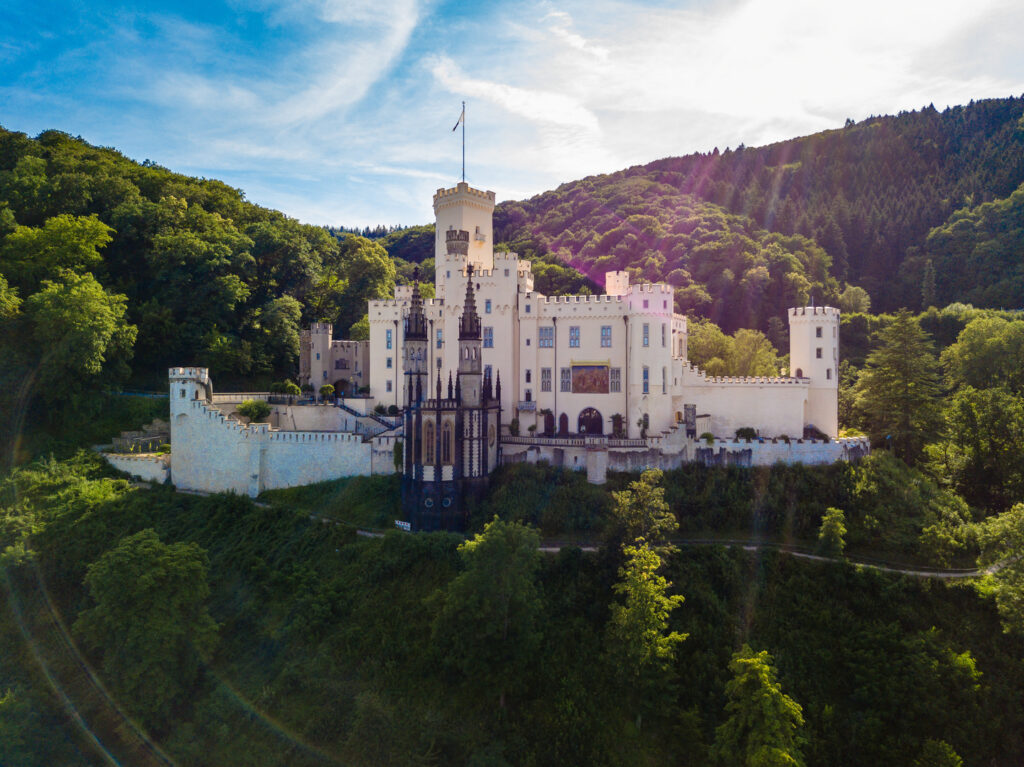Surroundings
Experience the Rhine and Moselle
Enjoy the beautiful Middle Rhine Valley, a UNESCO World Heritage Site since 2002:
- with its many castles and palaces,
- the magnificent river landscape of the Rhine,
- the extensive vineyards and forests,
- the historic Rhens, its town wall, towers and town gates, the Königsstuhl and many beautiful half-timbered houses
- the friendly, familiar atmosphere and Rhenish cheerfulness
Relax on a boat trip on the Rhine or take a bike tour along the Rhine and forget the stress of everyday life!
Rhens is the ideal starting point for your journey of discovery along the Rhine. From here you can be in Koblenz or Boppard in 10 minutes, whether for a shopping trip or to get to know the city.
The Rhenser Königsstuhl, Marksburg Castle, Stolzenfels Castle, Ehrenbreitstein Fortress and Lahneck Castle are in the immediate vicinity.
It is also not far to the other castles and palaces on the Rhine and Moselle.
In the UNESCO World Heritage Upper Middle Rhine Valley from Koblenz to Bingen, you have a multitude of castles and historic towns within a short distance.
The Loreley Valley - beautiful, steeped in legend and steeped in history.
Rhens
In the Middle Ages, the small town of Rhens near Koblenz was a focal point for the "western" powers of the German Empire - a neutral spot where the bishops of Cologne, Trier and Mainz as well as the Palatine Elector met to coordinate a common power policy, especially in the election of kings. Once situated at the four-country corner of the Rhenish electors, the place became famous in 1338 through the Kurverein of Rhense, which decided here on the king's independence from the Pope's blessing.
As early as 1273, preliminary discussions for the election of Rudolf of Habsburg as emperor took place there. At the beginning of the 14th century, further meetings were held, for example to procure the crown for Duke Ludwig of Bavaria.
The first real royal election in Rhens took place in 1346. Charles IV was elected Roman king and had the royal chair erected with a "steynen gestuel". However, with two exceptions - in 1400 Ruprecht of the Palatinate was still proclaimed king in Rhens - the elections remained in Frankfurt am Main. The kings made only one stopover in Rhens on their way from Frankfurt to Aachen, the place of their coronation. Destroyed at the end of the 18th century, today's Königsstuhl was rebuilt in 1842 and moved from its former location in a walnut orchard in the Rhine meadows to the hill near the road to Waldesch in 1929.
Also worth seeing in Rhens is the old town, which, with its many beautiful half-timbered buildings from the 16th and 17th centuries, beams, carvings, oriels and archways, lies closed in the largely preserved town wall. The half-timbered town hall dating from 1514, the old parish church, the sharp tower and the carbonated mineral spring (Rhenser Mineralbrunnen) are also particularly noteworthy.


Koblenz
In Koblenz, about 10 km away, it is worth visiting Ehrenbreitstein Fortress, a fortification that has existed since the 16th century, originally a Electorate of Trier, later a Prussian fortification, from where you have a beautiful view of the confluence of the Rhine and Moselle.
You should also visit the headland at the mouth of the Moselle into the Rhine, the Deutsches Eck, with its monument to Emperor Wilhelm I. Beautiful squares and alleys in Koblenz's old town invite you to stroll and linger.
Between Koblenz and Rhens, opposite the mouth of the Lahn, the Stolzenfels Castle stands above the Koblenz district named after it, a neo-Gothic castle that is considered the outstanding work of Rhine Romanticism.
Boppard
Approx. 10 km from Rhens in a southerly direction, many sights also await you in Boppard. The Roman fortification from the 4th century AD, the medieval town wall, the electoral castle and impressive churches offer visitors the opportunity to spend an eventful day in addition to a beautiful shopping street.
Hike or take the chairlift to the Vierseenblick on the Boppard Heights and enjoy the beautiful view of the largest loop of the Rhine, which at this vantage point looks as if it were four separate lakes due to overlapping slate slopes.








